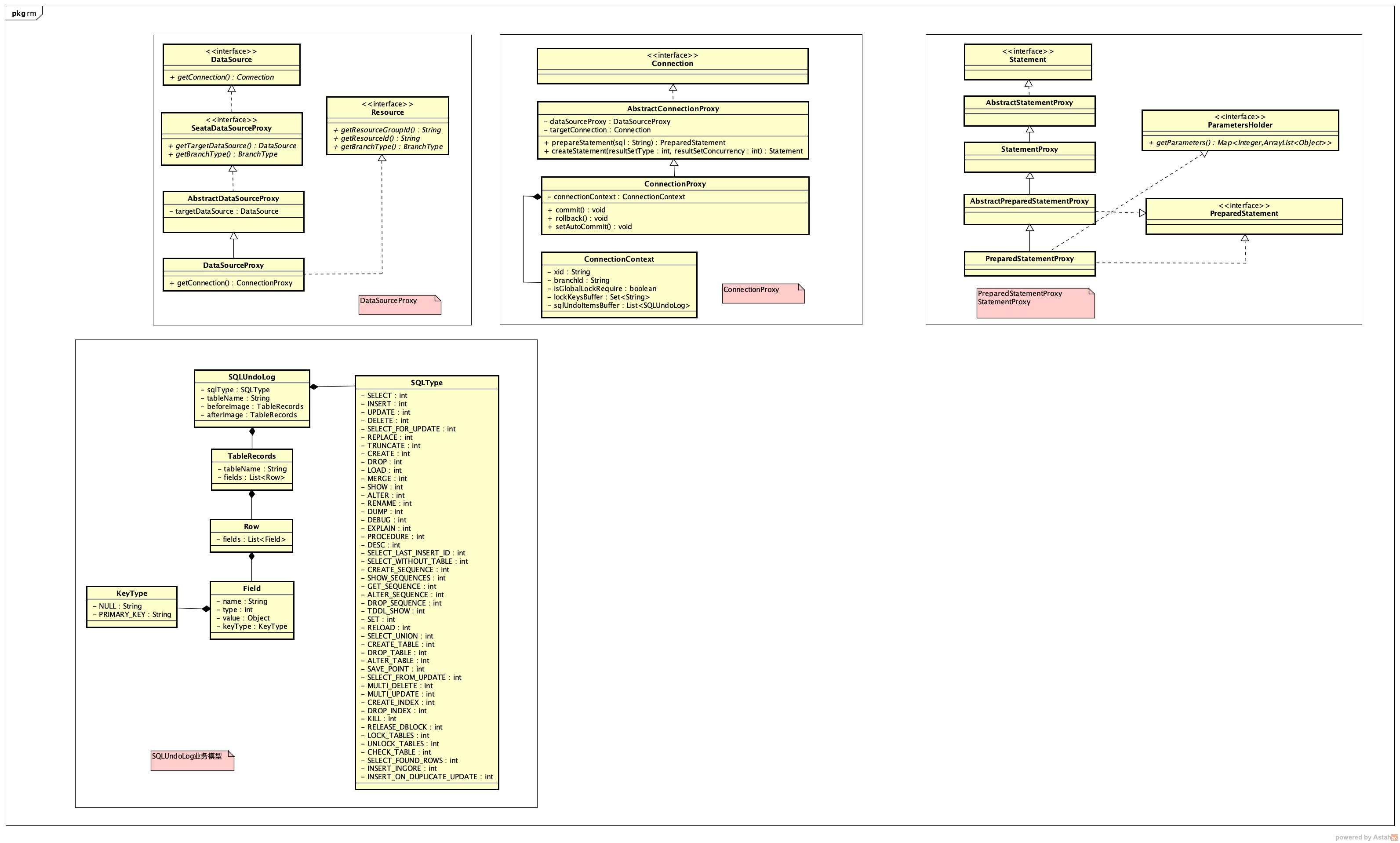(1). 先看下DataSourceProxy的类图
RM的类图有点多,不过,对于Java开发人员都很清楚的几个类(DataSource/Connection/Statement/PreparedStatement).
RM就是以DataSource为切入点.

(2). 先看几个Seata开发的拦截器
// SeataRestTemplateInterceptor
// 给RestTemplate增加拦截器,当ThreadLocal(RootContext)中有xid时
// 把xid通过Http Header的方法进行传递(key=TX_XID , value=xxx)
public class SeataRestTemplateInterceptor implements ClientHttpRequestInterceptor {
@Override
public ClientHttpResponse intercept(HttpRequest httpRequest, byte[] bytes,
ClientHttpRequestExecution clientHttpRequestExecution) throws IOException {
HttpRequestWrapper requestWrapper = new HttpRequestWrapper(httpRequest);
String xid = RootContext.getXID();
if (!StringUtils.isEmpty(xid)) {
requestWrapper.getHeaders().add(RootContext.KEY_XID, xid);
}
return clientHttpRequestExecution.execute(requestWrapper, bytes);
}
} // end SeataRestTemplateInterceptor
// SeataHandlerInterceptor
// 了解Spring MVC的应该知道:HandlerInterceptor是Spring MVC的拦截器
// 它的主要目的是:
// 1. 进入Controller方法之前(执行业务方法之前),如果Http Header中有:TX_XID,就把TX_XID的值,绑定到ThreadLocal(RootContext).
// 2. 离开Controller方法之后(执行业务方法之后),如果Http Header中有:TX_XID,就把ThreadLocal(RootContext)进行解绑.
public class SeataHandlerInterceptor implements HandlerInterceptor {
private static final Logger log = LoggerFactory
.getLogger(SeataHandlerInterceptor.class);
@Override
public boolean preHandle(HttpServletRequest request, HttpServletResponse response,
Object handler) {
String xid = RootContext.getXID();
// 从请求头中,获得:TX_XID
String rpcXid = request.getHeader(RootContext.KEY_XID);
if (log.isDebugEnabled()) {
log.debug("xid in RootContext {} xid in RpcContext {}", xid, rpcXid);
}
if (xid == null && rpcXid != null) {
// 绑定
RootContext.bind(rpcXid);
if (log.isDebugEnabled()) {
log.debug("bind {} to RootContext", rpcXid);
}
}
return true;
}
@Override
public void afterCompletion(HttpServletRequest request, HttpServletResponse response,
Object handler, Exception e) {
// 从请求头中,获得:TX_XID
String rpcXid = request.getHeader(RootContext.KEY_XID);
if (StringUtils.isEmpty(rpcXid)) {
return;
}
// 解绑
String unbindXid = RootContext.unbind();
if (log.isDebugEnabled()) {
log.debug("unbind {} from RootContext", unbindXid);
}
if (!rpcXid.equalsIgnoreCase(unbindXid)) { // 如果解绑后与Http请求头的中的不同
log.warn("xid in change during RPC from {} to {}", rpcXid, unbindXid);
if (unbindXid != null) {
// 重新绑定.
RootContext.bind(unbindXid);
log.warn("bind {} back to RootContext", unbindXid);
}
} // end
}
}// end
(3). 看下业务是如何配置RM的
package io.seata.sample;
@SpringBootApplication
@EnableEurekaClient
public class StorageApplication {
public static void main(String[] args) {
SpringApplication.run(StorageApplication.class, args);
}
// 1. 创建需要代理的DataSource
@Bean
@ConfigurationProperties(prefix = "spring.datasource")
public DataSource dataSource() {
DruidDataSource druidDataSource = new DruidDataSource();
return druidDataSource;
}
// 2. 创建:DataSourceProxy,它代理真实的DataSource(DruidDataSource)
@Primary
@Bean("dataSourceProxy")
public DataSourceProxy dataSourceProxy(DataSource dataSource) {
return new DataSourceProxy(dataSource);
}
// 3. 为jdbcTemplate配置数据源为代理的DataSource
@Bean("jdbcTemplate")
@ConditionalOnBean(DataSourceProxy.class)
public JdbcTemplate jdbcTemplate(DataSourceProxy dataSourceProxy) {
return new JdbcTemplate(dataSourceProxy);
}
}
(4). new DataSourceProxy
// **********************************************************************
// domain
private static final String DEFAULT_RESOURCE_GROUP_ID = "DEFAULT";
private String resourceGroupId;
private String jdbcUrl;
private String dbType;
private String userName;
// client.rm.tableMetaCheckEnable = false
private static boolean ENABLE_TABLE_META_CHECKER_ENABLE = ConfigurationFactory.getInstance().getBoolean(
ConfigurationKeys.CLIENT_TABLE_META_CHECK_ENABLE, DEFAULT_CLIENT_TABLE_META_CHECK_ENABLE);
// 表结构元数据检查间隔
private static final long TABLE_META_CHECKER_INTERVAL = 60000L;
// 定时任务
private final ScheduledExecutorService tableMetaExcutor = new ScheduledThreadPoolExecutor(1,
new NamedThreadFactory("tableMetaChecker", 1, true));
// **********************************************************************
// 1.
public DataSourceProxy(DataSource targetDataSource) {
this(targetDataSource, DEFAULT_RESOURCE_GROUP_ID);
} //end DataSourceProxy
// 2.
public DataSourceProxy(DataSource targetDataSource, String resourceGroupId) {
// 检查targetDataSource不能是:SeataDataSourceProxy
if (targetDataSource instanceof SeataDataSourceProxy) {
LOGGER.info("Unwrap the target data source, because the type is: {}", targetDataSource.getClass().getName());
targetDataSource = ((SeataDataSourceProxy) targetDataSource).getTargetDataSource();
}
this.targetDataSource = targetDataSource;
// *************************************
// 初始化
// *************************************
init(targetDataSource, resourceGroupId);
} //end DataSourceProxy
// 3.
private void init(DataSource dataSource, String resourceGroupId) {
this.resourceGroupId = resourceGroupId;
// 尝试的拿一个Connection
try (Connection connection = dataSource.getConnection()) {
// 从Connection中获得:jdbcurl
jdbcUrl = connection.getMetaData().getURL();
// 从Connection中获得:dbType
// dbType
dbType = JdbcUtils.getDbType(jdbcUrl);
// 如果是Oracle获得:userName
if (JdbcConstants.ORACLE.equals(dbType)) {
userName = connection.getMetaData().getUserName();
}
} catch (SQLException e) {
throw new IllegalStateException("can not init dataSource", e);
}
// ********************************************************************************
// DefaultResourceManager.get().registerResource这一部份主要是把RM的信息向TC汇报.进行资源的注册.
// 这一部份的内容,我留到下一节讲.
// 这是TC的日志:
// RM register success,message:RegisterRMRequest{resourceIds='jdbc:mysql://127.0.0.1:3306/fescar', applicationId='storage-service', transactionServiceGroup='my_test_tx_group'},channel:[id: 0x34606fb9, L:/172.17.12.122:8091 - R:/172.17.12.122:49749],client version:1.4.0
// ********************************************************************************
DefaultResourceManager.get().registerResource(this);
if (ENABLE_TABLE_META_CHECKER_ENABLE) { // false
// 开启了表元数据检查,则创建定时任务去做处理.
tableMetaExcutor.scheduleAtFixedRate(() -> {
try (Connection connection = dataSource.getConnection()) {
TableMetaCacheFactory.getTableMetaCache(DataSourceProxy.this.getDbType())
.refresh(connection, DataSourceProxy.this.getResourceId());
} catch (Exception ignore) {
}
}, 0, TABLE_META_CHECKER_INTERVAL, TimeUnit.MILLISECONDS);
}
// 设置ThreadLocal(RootContext)中的BranchType为:AT
//Set the default branch type to 'AT' in the RootContext.
RootContext.setDefaultBranchType(this.getBranchType());
} //end
public BranchType getBranchType() {
return BranchType.AT;
}// end getBranchType
(5). 总结
- DataSourceProxy需要包裹真实DataSource对象.
- DataSourceProxy在构建时,会向TC进行资源的注册(这部份专门用一小节来讲,会辅助UML进行分解).
- 可配置开启了表元数据检查.
